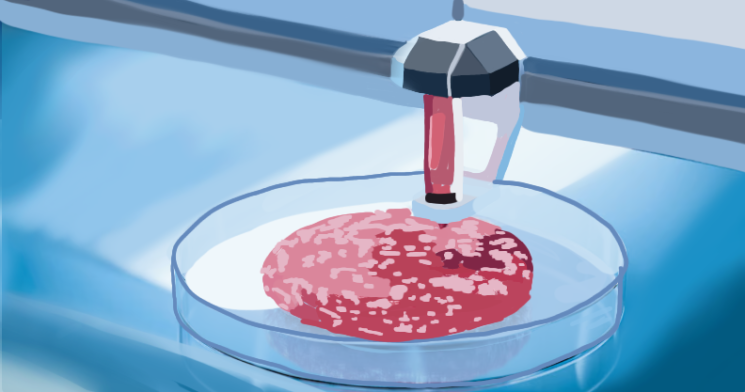
By Caroline Mora
For 2.4 million years, humans have eaten meat. However, in recent centuries, this has turned into an environmental issue. Following the Industrial Revolution, the demand for meat increased, creating what could be called one of the biggest climate change factors of the twenty-first century. Factory farming of livestock purely for human consumption contributes to deforestation, greenhouse gas emissions, and an immense amount of food waste.
As a result, one possible solution scientists predict could help to reduce the amount of pollution caused by mass meat consumption is 3D-printed meat.
I know what you’re thinking. 3D-printed meat? Doesn’t a 3D printer use plastic? The answer is yes and no. The printer used to create this type of product uses cultured animal cells that are then printed into the shape of a cut of meat. The result is oftentimes very realistic, and it has become a very real option for people who want to become more sustainable or have certain dietary restrictions towards animal-based products.
Environmental impact
The meat industry has been estimated to produce about 11.1-19.6% of the world’s carbon dioxide (CO₂) emissions. That’s at least 6.2 billion metric tons of CO₂. Large amounts of CO₂ and methane can contribute to global warming, a gradual heating event that leaves us with scorching summers and sporadic weather patterns throughout the year.
Global warming is a natural phenomenon but, in the last two centuries, this natural phenomenon has become something human-made. With an influx in the burning of fossil fuels for energy, deforestation, and farming livestock, this process, which should naturally happen over the course of centuries, has been rapidly increasing by 0.36℉ per decade since 1982.
By using lab-grown cells and shaping them into edible slabs of meat, we can reduce the carbon and methane emissions put out by farming these animals. Ruminant animals such as cows, sheep, and goats have 4 stomach compartments. Methane is produced due to the specific way that food is digested by these animals. The compartment called the rumen, the first stomach, has microorganisms called methanogens, that produce methane through the fermentation of their food and is then excreted as flatulence. There wouldn’t be as great a demand for livestock if lab-grown meat became the norm.
Dietary restrictions
Many variations of dietary restrictions are centered around avoiding certain types of meat. When it’s a religious restriction, usually it’s due to the animal the meat comes from or how the animal was killed. If the restriction is for health reasons, such as avoiding hot dogs, red meat or other processed meats on a heart-healthy diet, then avoid no more!
With lab-grown animal cells, all of the aforementioned restrictions could be laid to rest, within reason. If the cells come directly from an animal, which is not on the safe foods list, then the 3D-printed meat might not be okay to eat. However, for example, when it comes to a kosher diet, if the animal cells come directly from a kosher animal, then the cultured meat is perfectly safe to eat. Still, this all depends on the personal preference of the consumer.
Who is eating this?
Considering how many restaurants there are in the world, the select few that are serving lab-grown meat are few and far between. 3D-printed meat is most common in Europe, with countries like England, Germany, and the Netherlands having the most availability of these products in restaurants and stores. In Europe, the main company that produces lab-grown meat is Redefine Meat, which is based in Israel. One of the companies that produces cultured meat for the United States is Mission Barns, based in California. However, due to certain regulations and policies, it cannot be sold in the United States just yet.
The reality of this product is that it is still meat. It is not vegan since it comes from animal cells. However, if your reason for avoiding meat is to protest animal cruelty, then fear not. No animals were harmed in the making of this food!





